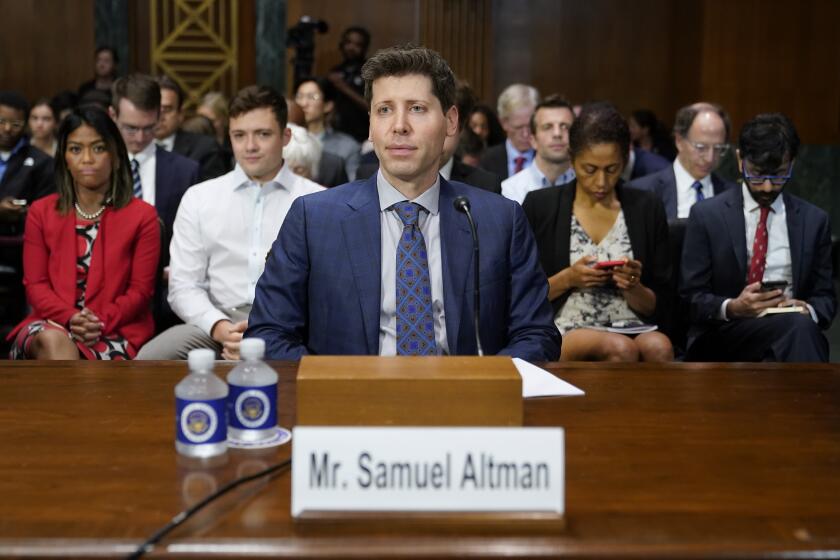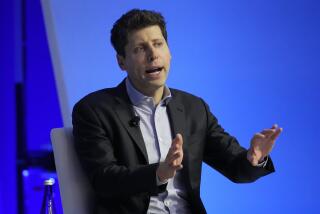Can a chatbot preach a good sermon? Hundreds attend church service generated by ChatGPT to find out

- Share via
FUERTH, Germany — The artificial intelligence chatbot asked the believers in the fully packed St. Paul’s church in the Bavarian town of Fuerth to rise from the pews and praise the Lord.
The ChatGPT chatbot, personified by an avatar of a bearded Black man on a huge screen above the altar, then began preaching to the more than 300 people who had shown up on Friday morning for an experimental Lutheran church service almost entirely generated by AI.
“Dear friends, it is an honor for me to stand here and preach to you as the first artificial intelligence at this year’s convention of Protestants in Germany,” the avatar said with an expressionless face and monotonous voice.
The 40-minute service — including the sermon, prayers and music — was created by ChatGPT and Jonas Simmerlein, a theologian and philosopher from the University of Vienna.
“I conceived this service — but actually I rather accompanied it, because I would say about 98% comes from the machine,” the 29-year-old scholar told the Associated Press.
The AI church service was one of hundreds of events at the convention of Protestants in the Bavarian towns of Nuremberg and the neighboring Fuerth, and it drew such immense interest that people formed a long queue outside the 19th century, neo-Gothic building an hour before it began.
The convention itself — Deutscher Evangelischer Kirchentag in German — takes place every two years in the summer at a different place in Germany and draws tens of thousands of believers to pray, sing and discuss their faith. They also talk about current world affairs and look for solutions to key issues, which this year included global warming, the war in Ukraine — and artificial intelligence.
This year’s gathering is taking place from Wednesday to Sunday under the motto “Now is the time.” That slogan was one of the sentences Simmerlein fed ChatGPT when he asked the chatbot to develop the sermon.
“I told the artificial intelligence ‘We are at the church congress, you are a preacher … what would a church service look like?’” Simmerlein said. He also asked for psalms to be included, as well as prayers and a blessing at the end.
“You end up with a pretty solid church service,” Simmerlein said, sounding almost surprised by the success of his experiment.
Indeed, the believers in the church listened attentively as the artificial intelligence preached about leaving the past behind, focusing on the challenges of the present, overcoming fear of death, and never losing trust in Jesus Christ.
The entire service was “led” by four different avatars on the screen, two young women, and two young men.
At times, the AI-generated avatar inadvertently drew laughter as when it used platitudes and told the churchgoers with a deadpan expression that in order “to keep our faith, we must pray and go to church regularly.”
Hundreds of business leaders and academic experts signed a brief statement from the Center for AI Safety, saying they sought to “voice concerns about some of advanced AI’s most severe risks.”
Some people enthusiastically videotaped the event with their cellphones, while others looked on more critically and refused to speak along loudly during the Lord’s Prayer.
Heiderose Schmidt, a 54-year-old who works in IT, said she was excited and curious when the service started but found it increasingly off-putting as it went along.
“There was no heart and no soul,” she said. “The avatars showed no emotions at all, had no body language and were talking so fast and monotonously that it was very hard for me to concentrate on what they said.”
“But maybe it is different for the younger generation who grew up with all of this,” Schmidt added.
Marc Jansen, a 31-year-old Lutheran pastor from Troisdorf near the western German city of Cologne, brought a group of teenagers from his congregation to St. Paul. He was more impressed by the experiment.
“I had actually imagined it to be worse. But I was positively surprised how well it worked. Also the language of the AI worked well, even though it was still a bit bumpy at times,” Jansen said.
What the young pastor missed, however, was any kind of emotion or spirituality, which he says is essential when he writes his own sermons.
Anna Puzio, 28, a researcher on the ethics of technology from the University of Twente in the Netherlands, also attended the service. She said she sees a lot of opportunities in the use of AI in religion — such as making religious services more easily available and inclusive for believers who for various reasons may not be able to experience their faith in person with others in houses of worship.
The tech site CNET brought in an artificial intelligence bot to write financial articles, but the product turned out to be worthless and even unethical.
However, she noted there are also dangers when it comes to the use of AI in religion.
“The challenge that I see is that AI is very human-like and that it’s easy to be deceived by it,” she said.
“Also, we don’t have only one Christian opinion, and that’s what AI has to represent as well,” she said. “We have to be careful that it’s not misused for such purposes as to spread only one opinion.”
Simmerlein said it is not his intention to replace religious leaders with artificial intelligence. Rather, he sees the use of AI as a way to help them with their everyday work in their congregations.
Some pastors seek inspiration in literature, he says, so why not also ask AI for ideas regarding an upcoming sermon. Others would like to have more time for individual spiritual guidance of their parishioners, so why not speed up the process of writing the sermon with the help of a chatbot to make time for other important duties.
“Artificial intelligence will increasingly take over our lives, in all its facets,” Simmerlein said. “And that’s why it’s useful to learn to deal with it.”
However, the experimental church service also showed the limits to implementing AI in church, or in religion. There was no real interaction between the believers and the chatbot, which wasn’t able to respond to the laughter or any other reactions by the churchgoers as a human pastor would have been able to do.
“The pastor is in the congregation, she lives with them, she buries the people, she knows them from the beginning,” Simmerlein said. “Artificial intelligence cannot do that. It does not know the congregation.”
More to Read
Sign up for Essential California
The most important California stories and recommendations in your inbox every morning.
You may occasionally receive promotional content from the Los Angeles Times.












